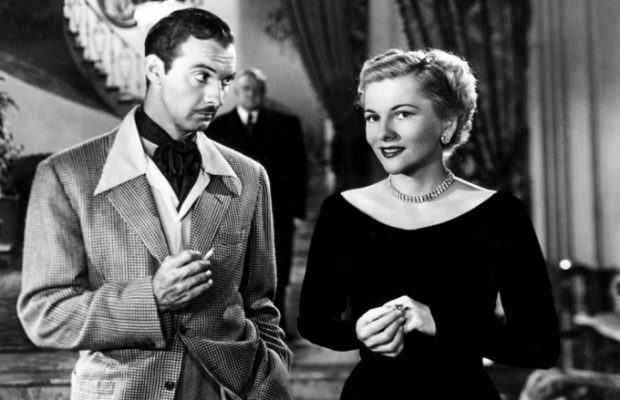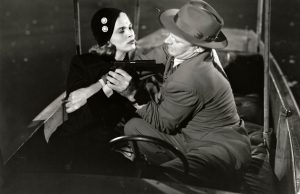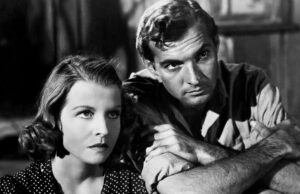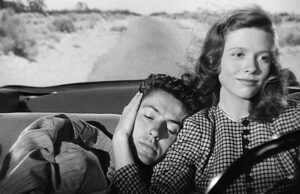Born to Be Bad (1950)

Toronto Film Society presented Born to Be Bad (1950) on Monday, August 21, 2017 in a double bill with Flaxy Martin as part of the Season 70 Summer Series, Programme 6.
Production Company: RKO Radio. Producer: Robert Sparks. Director: Nicholas Ray. Screenplay: Charles Schnee, Edith R. Sommer, from the novel “All Kneeling” by Anne Parrish. Cinematography: Nicholas Musuraca. Film Editor: Frederic Knudtson. Music: Frederick Hollander. Release Date: July 15, 1950.
Cast: Joan Fontaine (Christabel Caine Carey), Robert Ryan (Nick Bradley), Zachary Scott (Curtis Carey), Joan Leslie (Donna Foster), Mel Ferrer (Gabriel “Gobby” Broome), Harold Vermilyea (John Caine), Virginia Farmer (Aunt Clara Caine), Kathleen Howard (Mrs. Bolton), Bess Flowers (Mrs. Worthington).
Born to Be Bad was the first film Joan Fontaine made after the birth of her daughter, Debbie. Joan Harrison, Hitchcock’s writer, had shown her the novel “All Kneeling” by Anne Parrish, and suggested it might make an interesting vehicle for her, one that would give Joan a chance to break away from the English lady heroines that she’d been playing. She bought the rights to the book and sold them to R.K.O. In her autobiography, she doesn’t mention why but she was unhappy with the whole making of the film; her director Nicholas Ray, her costars Robert Ryan, Zachary Scott and Mel Ferrer, commenting that the only acceptable part of the film was her wardrobe, which was designed by Tina Leser.
During the making of this film, Howard Hughes bought R.K.O., including Joan’s contract. So her new boss was the same man who had been proposing to her for over ten years. Although she was married, Hughes knew through the grapevine that a divorce for Joan and her husband film producer William Dozier was just around the corner. He persisted, but the relationship never led anywhere.
Robert Ryan’s point-of-view wasn’t that much different than Joan’s. His patience was tested by Born to Be Bad and up until the 1990s, the film was virtually forgotten for unknown reasons. The writer of Robert Ryan’s biography, Franklin Jarlett, felt that as a high-class soap opera, much in the tradition of other “high society” films of the 30s and 40s, Born to be Bad’s San Francisco setting and sophisticated dialogue should have been better received. Perhaps, he surmised, R.K.O.’s desire to make the film was another ill-advised maneuver, since its creation happened after that type of picture had exhausted its potential. It fell into a hazy category as a film noir, despite the established melodramatic credentials of Born to Be Bad’s stars. And since R.K.O. was less known for its classier acts than for its quickie potboilers, the public and critics alike seem to have been unprepared for the film.
R.K.O.’s casting of Ryan opposite Fontaine reflected a confidence in him as a virile male presence, while his role as a successful writer with a shrewd sense about women seemed natural. But for unclear reasons, the more influential film critics failed to give Born to Be Bad more than a cursory glance, and it disappeared from theatres after a brief run.
When reading about director Nicholas Ray’s psychological approach to making this film, he projected a range of sexuality—bi, hetro and homo—onto his characters, and this may have been something the actors and audiences were subconsciously uncomfortable with in 1950.
“All Kneeling”, the book the film was based on, was written in 1928 by three-time Newbery Honor winner, Anne Parrish. She came from a distinguished and artistic Philadelphia family. Her younger brother was author Dillwyn Parrish. Anne trained at the Philadelphia School of Design for Women, although she later chose a career in literature.
Sourced from No Bed of Roses: An Autobiography by Joan Fontaine (1978),
Robert Ryan: A Biography and Critical Filmography by Franklin Jarlett (1990) and
Lonely Places, Dangerous Ground: Nicholas Ray in American Cinema edited by Steven Rybin and Will Scheibel (2014)
Introduction by Caren Feldman
Plot: Christabel Caine (Joan Fontaine) goes to live with her innocent cousin Donna (Joan Leslie) and appears to be very sweet and pious. The sweetness soon turns sour as Christabel falls for Donna’s rich fiancé, Curtis (Zachary Scott), and plans on getting him to leave Donna. She is also interested in the author Nick Bradley (Robert Ryan), while trying to convince Curtis that Donna is only after his money. She succeeds in breaking the couple up and marries Curtis herself, while developing a relationship with Nick on the side.
Critical Response: Critic Dennis Schwartz calls it a “trashy but stylishly entertaining melodrama” that “moves in trite soap opera circles reaching a predictable outcome, but Ray keeps all the viciousness going full blast, thereby drawing an ugly picture of the bankrupt emotional state of society life”. Another critic, Craig Butler, calls it “a bitchy, campy, over-the-top melodrama with little time to waste on subtlety” that “presents its soap in the most operatic terms possible”, but “a lot of fun”, nevertheless.
Nicholas Ray (1911-1979): Born Raymond Nicholas Kienzle, he chose to reverse his first two names as part of a turbulent childhood and adolescence in which he was prone to delinquency and alcohol abuse and graduated from high school next to bottom in his class, despite high marks in English and public speaking. He went on to study drama at the University of Chicago, but lasted only one semester, in the course of which he made friends with architect Frank Lloyd Wright and playwright Thornton Wilder, before joining the Federal Theater Project. There, he worked with Joseph Losey, John Houseman, and Elia Kazan, and traveled with the folklorist Alan Lomax to collect traditional American folk songs in support of artists like Woody Guthrie and Pete Seeger. He then moved to New York, where he was assistant director to Kazan on A Tree Grows in Brooklyn, in 1945, and worked briefly on Broadway before directing his first film for RKO, They Live By Night, which demonstrated his perennial sympathy for youthful outsiders and outcasts. The film was well received and led to further work, mostly in films-noir, over the next few years, such as On Dangerous Ground, Knock On Any Door, The Lusty Men, and one of his finest films, In a Lonely Place (1950), starring Humphrey Bogart and Gloria Grahame (to whom he was briefly married).
Then came two colour works, Johnny Guitar (1954) and the film by which he is best known, Rebel Without a Cause (1955), starring James Dean. His use of vibrant colour and his mastery of CinemaScope in these films and Bigger Than Life (1956), with their raw emotional power and unbridled visual excess, proved disconcerting to American critics, but helped to establish him as a favourite of the young French critics and filmmakers of the nouvelle vague, especially Jean-Luc Godard and François Truffaut. In the meantime, however, he was developing serious addictions to drugs and alcohol that made it difficult for producers to work with him, and he began to be shut out of the Hollywood industry, despite making two powerful epics, King of Kings (1961) and 55 Days at Peking (1963). During the 1970s, he taught filmmaking at Binghamton University and New York University, and made an experimental film called We Can’t Go Home Again with his students. He died of lung cancer while working with the German director Wim Wenders on his film Lightning Over Water.
Joan Fontaine (1919-2013): Born Joan de Beauvoir de Havilland in Tokyo to British parents who separated in 1919, after which her mother, a stage actress, took Joan and her older sister, Olivia, to the United States, where they settled in California. Joan returned to live with her father in Japan when she was sixteen and then returned to the U.S. in 1935, where she made her stage début (taking the professional name of Joan Fontaine) and was soon signed by RKO. After appearing in some minor roles, she became touted as a rising star, appearing with Fred Astaire in A Damsel in Distress, in 1937; but when the film flopped, she was reduced to minor roles once more, and her contract was not renewed. After meeting producer David O. Selznick in 1940, and discovering that they were both interested in Daphne du Maurier’s novel Rebecca, Selznick asked her to audition for the leading role in his planned film of the book, to be directed by Alfred Hitchcock. After competing with hundreds of other actresses, she secured the role. The film received glowing reviews and she was nominated for an Academy Award for Best Actress; though she did not win, that year; she won for Best Actress in 1942 for Hitchcock’s Suspicion.
Her award served to accentuate the budding rivalry (dating, apparently, from their childhood) between herself and her actress sister, Olivia de Havilland, who had been nominated the same year for her role in Hold Back the Dawn. Fontaine, apparently, deliberately slighted de Havilland when her sister attempted to congratulate her on winning the award. This, apparently, inaugurated a lifelong feud that lasted until 1975 and later resulted in mutual accusations concerning medical treatment of their ailing mother. Meanwhile, Fontaine’s career flourished in such films as The Constant Nymph (1943), Jane Eyre (1943), and Letter From an Unknown Woman (1948). She turned more to radio, television, and the stage, in the 1950s, winning some acclaim for stage productions, in particular, before retiring in 1994. She was married and divorced four times, including to actor Brian Aherne from 1939 to 1945.
Robert Ryan (1909-1973): “A gifted, intelligent, and powerful actor”; a liberal Democrat and pacifist; a tireless supporter of civil rights and racial equality; and a strong opponent of McCarthyism, Ryan was paradoxically best known for roles depicting, as he put it, the kind of character that in real life he found totally despicable. After graduation from Dartmouth College, where he was the school’s heavyweight boxing champion every year, he worked as a ranch hand and ship’s stoker before taking small roles in film and on stage, in the early 1940s, and becoming a drill instructor for the Marine Corps. There, he became friendly with Richard Brooks, author of the novel The Brick Foxhole, which was made as the film Crossfire, in which Ryan had his breakthrough film role. He followed this with major work in many of the finest films, and for many of the finest directors, of the next three decades—Nicholas Ray, Anthony Mann, Robert Wise, Samuel Fuller, Fritz Lang, John Sturges, Robert Aldrich, Richard Brooks, and Sam Peckinpah—in such films as: On Dangerous Ground; The Set-Up; The Naked Spur; Bad Day at Black Rock; The Dirty Dozen; The Professionals; and The Wild Bunch. He also acted on stage, mostly for off-Broadway productions and regional theatres, and for television (though always as a guest star and never in a series, where he might, as he put it, end up being typecast as “Sidewinder Sam” for the rest of his life).
Mel Ferrer (1917-2008): Born of mixed Irish and Cuban descent, he was privately educated before attending Princeton University, though he dropped out from there to devote himself to acting. He worked for a time on Broadway, then moved into film, making his screen début in 1949 and appearing later in Rancho Notorious (1952); Lili (1953); Scaramouche (1952); Knights of the Round Table (1953); and War and Peace (1956), among others. He later worked mostly in television.
Joan Leslie (1925-2015): She showed an early interest and talent for music and, when her father lost his job in the Depression, she and her two older sisters toured as vaudeville performers, under the name of The Three Brodels, in order to support the family. While touring, she caught the attention of an M.G.M. scout and was given a film contract as a child actor. But she made little impact at M.G.M., and the studio let her go. After some time working independently, she signed with Warner Brothers and had success as the crippled girl Velma in High Sierra, in 1941. This was followed by roles in Sergeant York (1941), Yankee Doodle Dandy (1942), and others, where she gained a reputation for “sweet innocence without being too sugary”. She soon tired of this, wanting more serious and mature roles, and took Warners to court in order to get released from her contract. Jack Warner retaliated by persuading other major studios to blacklist her, resulting in her being forced to work, instead, for “Poverty Row” outfits, such as Republic. Her last film was The Revolt of Mamie Stover, in 1956, after which she retired from acting, apart from occasional appearances on television.
Nicholas Musuraca (1892-1975): One of the now most highly regarded of Hollywood cinematographers, after years spent in obscurity, in particular for his development of the characteristic visual style of film-noir, based on darkness and shadows. Major films were: Bedlam; Cat People; Out of the Past; Blood on the Moon; Clash By Night; The Locket; The Spiral Staircase; The Seventh Victim; Born to Be Bad; and The Mad Miss Manton.
Notes by Graham Petrie













Leave a Reply